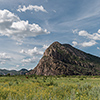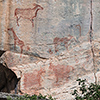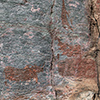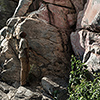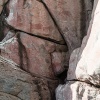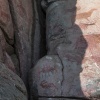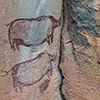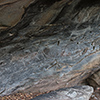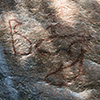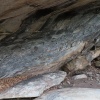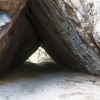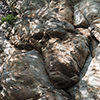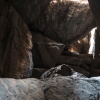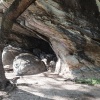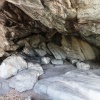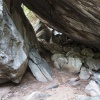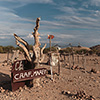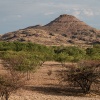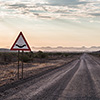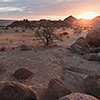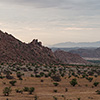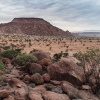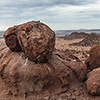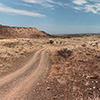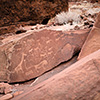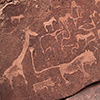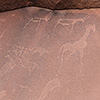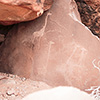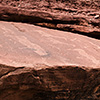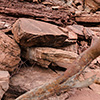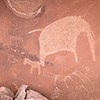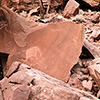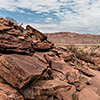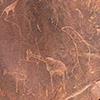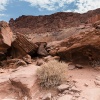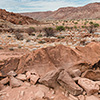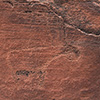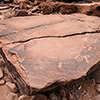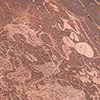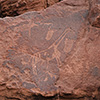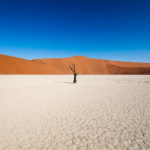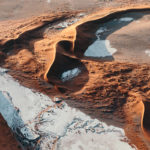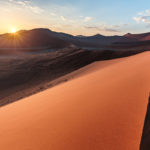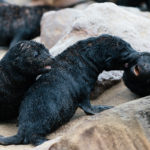Wales in the Desert – The Rock Paintings of Tsodilo Hills and Twyfelfontein
The black continent can look back onto a far-reaching history as among all landmasses of our planet Africa is inhabited by humans for the longest time. References of that time are the various rock painting site. Two of them are Tsodilo Hills in Botswana as well as the mountain area of Twyfelfontein in Namibia’s Damaraland. Both spots are UNESCO World Heritage Sites and served as temporary settlement places to nomadising San people, a tribe that today is known as Bushmen. Their rock paintings and engravings stood the time of millennia. There’s a reason why we say “It began in Africa…”
Botswana’s landscape is not really high alpine, hence only the intellectually challenged would miss the mountains of Tsodilo Hills and its Male Rock being visible over a very long distance. With an altitude of 1489 metres that rock is also Botswana’s tallest elevation. Unlike near Okavango Delta the setting of Tsodilo Hills is dry and lacks of water making my jeep dragging along a dense, very long trail of fine white dust.
The almost 40 kilometres long path from the pothole dream called A35 to the actual hill area is no problem for a normal car, but to drive down to the mountain foot a 4×4 is needed. There guides await visitor to take them on different walkabouts. I am the last visitor before sun sets and got the honour to get very skilled Thebe explaining me everything that the San people made, engraved and painted. Sturdy shoes and longs pants are recommended as snakes are around.
Terminology already says everything: rock paintings are works applied onto the stone while engravings got cut into rocks. There is one basic common thing though as with images of animals the San people tell stories of their nomadic migrations through the southern African continent. Logically lots of antelopes, rhinos, lions and elephants got eternalised but most interesting are the pictures displaying wales or penguins, which can be seen as proof that the San tribe even made it down to South Africa and back.
Erosion is one of the strongest natural forces. It is more than astonishing to eye-witness that paint only made from blood and fat can resists any kind of wind and weather for more than unbelievable 20.000 years. What a sustainable stability! Against that background things like the ever postponed Berlin International Airport or the steel beam torn off Berlin’s central station by storm Kyrill right after it started operations appear like a goddamn botching. It would be very interesting to see the reaction of sustainably living San people if they would know about the bullshit white men did/does calling that progression.
Beside smaller other mountains the Tsodilo Hills massif consists of a prominent pointy main rock, so called Male Rock, as well as a lower mountain with a flat peak, that is the so called Mother Rock. That constellation provides many little shelters, hence it’s no surprise to meet caves that nowadays do the same thing like they did thousands of years ago, that is providing shadow and coolness. One of those hideaways from African heat was apparently used for cooking as the fire blackened rock tells, another cave was a saloon where in the middle a pretty flat stone with thimble-deep notches can be found that worked as ancient board game. The San also had something like Nine Man Morris, Draughts or Ludo. Incredible!
Hence it is no surprise to find their artistic remains also in Namibia’s Damaraland, a region southwest of Etosha pan where living conditions become remarkably tough and arid.
The word Twyfelfontein, meaning “uncertain spring” and originating from Afrikaans language, illustrates verbally what the Khoikhoi were faced with if annual precipitation is less than 150mm. Their rock engravings are like the San paintings, but due to lack of precious water (nothing else is blood) they preferred to cut their images into stone. Like in Tsodilo Hills the penguin-shaped engravings symbolise that in Damaraland-based Khoikhoi made it down to South Africa.
Due to erosion and (will wonders never cease!) even tectonic activity the rocks of Tweyfelfontein are pretty much tumbled over whereas at Tsodilo Hills a solid mountain works as a long lasting projection surface for the paintings. It is said that the German land surveyors Volkmann and Maack discovered the Namibian rock engraving site, that is estimated of being up to 20.000 years old as well.
One big common thing between Twyfelfontein and Tsodilo Hills is that hunter gathered at those mythical places among the colourful rocks to make contact to their ancestors, for example after an unsuccessful hunt; at Twyfelfontein you can see many carvings showing that.
Furthermore the images displaying animals were a book and served the elder to transfer their knowledge to the younger. The biggest show is a stone plate with different small and big circle symbols, which is one of the very first maps of humanity giving information about water resources, their volume and reliability.
The star of Twyfelfontein and worldwide known is the lion plate showing a giraffe, several antelopes and a big image of the king of animals. At its end the predator’s long tail splits up into five finger-like extensions. Same happens with the paws, meaning that the animal has got five toes. All that is a strong indication that first and foremost the image is homage to masquerading shamans and not only a dedication to a big cat.
Both places tell a lot about old Africa’s historical and social structures. African people lived in tribes and people like hunters, shamans and chiefs played an important role. Latter one, the chief, also involves the biggest conflict potential as infinitely arrogant white people imposed their western system on the Blacks guising that as democracy. New Africa, its countries and borders, is pretty young and in that world the chiefs got deliberately replaced by random governors having only one purpose that is being servants to new power structures. Logically that attacked and destroyed historically grown things within very short time.
That is one of the main reasons for South Africa’s prospering violence as there is quite a lack of people feeling really tied to Jacob Zuma. His filthy corrupt regime is quite a negative example if Jacob’s personal pool (worth millions of Euros!) gets built but then becomes declared as fire-extinguishing pond to finally pay it fully from tax payers’ money. It is not like you arrive the Jo’Burg airport and hardly make it out alive, but with statistically seen 47 murders per day South Africa is more dangerous than some of the world’s war zones. Understandably some South African white people speak about their country descending into a civil war.
